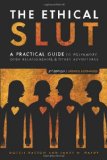I am leading a read-through of The Ethical Slut, 2nd edition. If you’d like to catch up on past installments, check the list at the bottom of the series introduction. Comments on the topics in this discussion are welcome anytime, even from people who aren’t following along in the book.
This week, the read-along continues with a discussion based on Chapter 16, “Opening Up An Existing Relationship”

There are a few lucky people out there who figure out polyamory almost right from the start, perhaps during high school explorations with others or even before. Some few learn about the open relationships of parents or other adults. Others may never consider alternatives at all until a lover wants to move beyond monogamy. Obviously, many people also fall somewhere between — those who have considered open relationships before, but never been in one until they find themselves in love with someone who was more actively poly.
One of the concepts in this chapter of The Ethical Slut is that usually there is one person who is actively seeking polyamory (what the authors refer to as the “adventurous partner”). Of course there is still the other partner’s feelings to consider, as well as those of the outsider to the relationship, if they exist beyond the hypothetical: the person who the adventurous partner wants to date. The book attempts to give advice to each for maintaining sanity and figuring out a way through this confusing time. It also deals with the added complication of cheating, when someone wants to turn a dishonest relationship into an open, honest one.
As I discussed in my personal background, I came to polyamory after encountering the idea in fiction and roleplay first. Even so, the first two times I experimented with openness both involved a girlfriend that was the more adventurous partner. They had found someone else to play with or date and brought it up with me. In both relationships, I struggled with jealousy as the ideas I’d found in fiction and fantasy warred with what society told me was normal, and a real fear of loss. In both cases, I did lose my lovers to the other person shortly after.

Despite that, I now embrace polyamory as a way to build relationships that fit me and those I love. I didn’t become polyamorous because anyone forced me into it, but because I came to it at my pace and realized that it was right for me. It was a lover asking for openness that forced me to face the issue as it related to my life, but it was my personal insight that led me to take this path.
Would it have helped to read this book during either of those relationships? There’s solid advice here for maintaining one relationship while you add others, and for getting through the struggles of the first time. Perhaps the book would have helped us see things with more clarity, or communicate a little better, but I can’t imagine they would have changed the outcome. These were juvenile relationships, with very little in common with the relationships I find myself in today, nor with the sorts of people I date.
I think that’s why I don’t have as much to offer about this topic as I might other times. Because they were so long ago, and we just blundered about until we broke up, I can’t really share great pearls of wisdom. After that second time, all relationships I’ve entered into have been open ones, and my life is better for it.
Since I don’t have recent experience, I’ve asked some other writers to give me their views on the topic of opening up. Tomorrow, we’ll have a guest post from Jessica Burde of Polyamory Practically on becoming a triad. In the next installment of the read-along (Thursday, July 14) we will discuss Chapter 17, “Making Connection.” In the meantime, share your experiences in the comments — or get in touch if you want to write a guest post too. I’m always open to essays about polyamory, sex, Burning Man, writing or any of the other topics of this blog.